Education Edge is a leader in professional education and carries out its mission to deliver excellence with pride and focus on the future. https://www.educationedge.ca
Don't wanna be here? Send us removal request.
Text
Immigrating to Canada
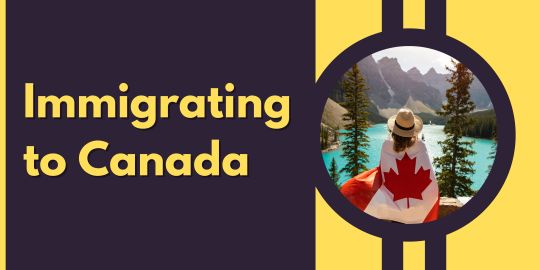
Are you considering moving to Canada? Whether it's for better opportunities, education, or simply a change of scenery, Canada is a welcoming country with a diverse culture and vast opportunities. But how do you go about immigrating to Canada? Here's a simple guide to help you navigate the process.
1. Understand the Immigration Programs
Canada offers various Canada Immigration programs, each designed for different purposes and individuals. Some popular programs include:
Express Entry: This program is for skilled workers who want to become permanent residents. It manages applications for three federal economic immigration programs: the Federal Skilled Worker Program, the Federal Skilled Trades Program, and the Canadian Experience Class.
Provincial Nominee Program (PNP): Each province and territory in Canada operates its own immigration programs designed to meet its specific economic and demographic needs. These programs allow provinces to nominate individuals who wish to immigrate to Canada and who are interested in settling in a particular province.
Family Sponsorship: If you have a family member who is a Canadian citizen or permanent resident, they may be able to sponsor you to come to Canada as a permanent resident.
2. Determine Your Eligibility
Before applying for any immigration program, it's essential to determine if you are eligible. Each program has its own set of requirements concerning factors such as age, education, work experience, language proficiency, and adaptability. You can use online tools provided by the Canadian government to check your eligibility for different programs.
3. Gather Required Documents
Once you've identified the immigration program you're eligible for, gather all the necessary documents. These may include identification documents, educational certificates, proof of work experience, language test results, and any other documents requested by the specific program.
4. Submit Your Application
After gathering all the required documents, submit your application online through the official website of the Government of Canada or the province you're applying to. Follow the instructions carefully and ensure that all information provided is accurate and up-to-date.
5. Wait for a Decision
After submitting your application, you'll need to wait for a decision. Processing times vary depending on the program and the volume of applications received. You can check the status of your application online using the unique identification number provided to you upon submission.
6. Prepare for Arrival
If your application is approved, congratulations! You'll receive a confirmation of permanent residence and instructions on how to proceed. You'll need to make arrangements for your arrival in Canada, including securing housing, finding employment (if necessary), and familiarizing yourself with your new community.
Conclusion
Immigrating to Canada can be a life-changing experience filled with opportunities for personal and professional growth. By understanding the Canada Immigration programs available, determining your eligibility, and following the application process diligently, you can make your dream of living in Canada a reality. Remember, patience and persistence are key throughout the immigration journey.
0 notes
Text
5 Easy Ways to Immigrate to Canada Without Taking the IELTS Exam

Moving to Canada is a dream for many people around the world. It's a country known for its high quality of life, excellent healthcare, and diverse culture. However, one of the hurdles that many potential immigrants face is the requirement to take the International English Language Testing System (IELTS) exam. But did you know that there are alternative routes to Canada Immigration without needing to take the IELTS exam? Here are five simple ways you can make your Canadian dream a reality:
Provincial Nominee Program (PNP): Many provinces in Canada have their own immigration programs known as Provincial Nominee Programs (PNPs). These programs allow provinces to nominate individuals who want to immigrate and settle in that particular province. Some PNPs do not require applicants to take the IELTS exam. Each province has its own eligibility criteria and application process, so make sure to research which province's PNP suits you best.
Family Sponsorship: If you have a close relative who is a Canadian citizen or permanent resident, they may be able to sponsor you for immigration. Under the Family Class sponsorship program, certain relatives can sponsor their family members to immigrate to Canada. This route often does not require applicants to take the IELTS exam, although you may still need to demonstrate basic language proficiency through other means.
Work Permit Through LMIA: The Labor Market Impact Assessment (LMIA) is a document that Canadian employers may need to obtain before hiring foreign workers. If you secure a job offer from a Canadian employer who is willing to support your immigration process by obtaining an LMIA, you may be eligible for a work permit without needing to take the IELTS exam. This can eventually lead to permanent residency through programs like the Canadian Experience Class (CEC).
Quebec Experience Program: If you have studied or worked in the province of Quebec, you may be eligible for the Quebec Experience Program (PEQ). This program offers a streamlined immigration process for individuals with Quebec work experience or education. In many cases, applicants do not need to take the IELTS exam as part of their application.
Investor Immigration: Canada offers various investor immigration programs that allow individuals to obtain permanent residency by investing in the Canadian economy. These programs typically require applicants to demonstrate their net worth and make a significant investment in a Canadian business or government fund. While language proficiency may still be assessed, some investor immigration programs do not require applicants to take the IELTS exam.
In conclusion, while the IELTS exam is a common requirement for Canada Immigration, there are alternative pathways available for those who prefer not to take the test. Whether through provincial nominee programs, family sponsorship, work permits, or investor immigration, there are options to fulfill your Canadian dream without needing to tackle the IELTS exam. It's essential to research and choose the immigration pathway that best suits your qualifications, experience, and goals. With determination and the right guidance, immigrating to Canada can be a smooth and achievable process.
0 notes
Text
Immigration Opportunities for Unskilled Workers in Canada
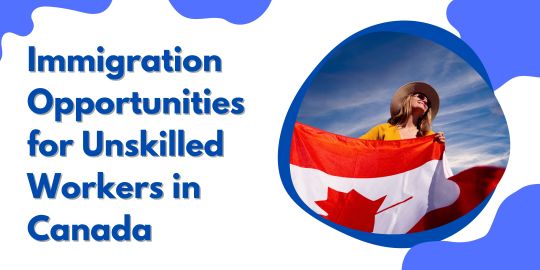
Are you dreaming of starting a new life in Canada? Maybe you've heard about the beautiful landscapes, friendly people, and great opportunities awaiting you there. But you might be wondering, "Can I move to Canada even if I don't have a fancy degree or a high-paying job?" The answer is yes! Canada Immigration welcomes unskilled workers too, and here's how you can make your dream a reality.
First things first, what does "unskilled worker" mean? Simply put, it means you don't need a specialized education or training for your job. It could be anything from farming and cleaning to construction and hospitality. Canada values people with all kinds of skills, not just the ones that require a university degree.
Now, let's talk about the pathways you can take to immigrate to Canada as an unskilled worker:
Temporary Foreign Worker Program (TFWP): This program allows Canadian employers to hire workers from other countries for temporary jobs when they can't find Canadians to fill the positions. If you get a job offer from a Canadian employer through this program, you can apply for a work permit to come to Canada and work for a specific period of time. Keep in mind that this is temporary, but it can be a stepping stone towards permanent residency.
Provincial Nominee Programs (PNPs): Each Canadian province has its own immigration programs, and some of them are designed to attract unskilled workers. These programs are tailored to the specific needs of each province, so you might find opportunities in industries like agriculture, hospitality, or construction. If you're nominated by a province, you can apply for permanent residency through the Provincial Nominee Program.
Express Entry Program: While this program is mainly for skilled workers, there are some pathways within Express Entry that could be open to unskilled workers. For example, if you have a valid job offer from a Canadian employer, you may be eligible to apply through the Federal Skilled Worker Program or the Federal Skilled Trades Program. Keep an eye on the eligibility requirements and see if you fit the criteria.
Atlantic Immigration Pilot (AIP): If you're interested in working in one of the Atlantic provinces (Nova Scotia, New Brunswick, Prince Edward Island, or Newfoundland and Labrador), the AIP might be a good option for you. This pilot program aims to fill labour shortages in the Atlantic region by connecting employers with skilled and unskilled workers from other countries. If you get a job offer through the AIP, you can apply for permanent residency.
Now, let's address some common questions and concerns you might have:
Do I need to speak English or French? Yes, language proficiency is important for immigrating to Canada. You'll need to take a language test to prove your proficiency in English or French, depending on the requirements of the immigration program you're applying to.
What about education and work experience? While some programs may require a certain level of education or work experience, there are options available for unskilled workers too. Focus on showcasing your skills and experience relevant to the job you're applying for.
How long does the immigration process take? The timeline can vary depending on the program you apply through and other factors like processing times and the number of applications received. It's important to be patient and stay informed about the progress of your application.
Moving to a new country can be a big step, but with the right information and guidance, it's possible to achieve your goal of Canada Immigration as an unskilled worker. Take the time to research your options, gather the necessary documents, and prepare for the journey ahead. Canada is waiting for you with open arms!
0 notes
Text
Canada Immigration for Low-Skilled Workers: Opportunities and Pathways.
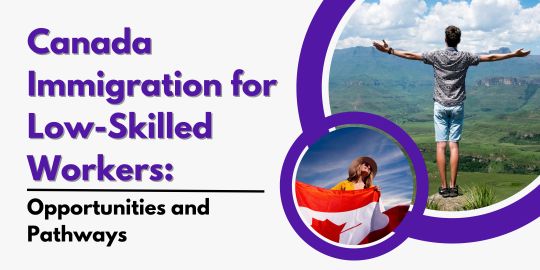
Canada is known for its welcoming attitude towards Canada Immigration from all walks of life, including those with low-skilled backgrounds. If you're considering moving to Canada for work but worry about your skill level, fret not! Canada offers various pathways and opportunities for individuals seeking employment in low-skilled sectors.
Understanding Low-Skilled Work:
Low-skilled work doesn't mean unimportant work. It refers to jobs that typically require minimal formal education or specialized training. These jobs are vital to many industries, such as hospitality, retail, agriculture, and construction. They include roles like cleaners, farmworkers, kitchen helpers, and retail associates.
Pathways to Canada:
Temporary Foreign Worker Program (TFWP): This program allows Canadian employers to hire foreign workers temporarily to fill labor shortages. If you secure a job offer from a Canadian employer, you may be eligible to apply for a work permit through this program.
Seasonal Agricultural Worker Program (SAWP): If you have experience in agriculture, the SAWP might be a suitable option. It allows farmers to hire foreign workers for seasonal agricultural work when Canadian workers are unavailable.
Provincial Nominee Programs (PNPs): Many provinces in Canada have PNPs that target specific labor needs. Some provinces offer streams dedicated to low-skilled workers, making it easier for them to immigrate if they meet certain criteria.
Caregiver Programs: Canada recognizes the importance of caregivers and offers pathways for them to immigrate. If you have experience as a caregiver for children, the elderly, or individuals with medical needs, you may qualify for these programs.
Atlantic Immigration Pilot (AIP): This program targets skilled and intermediate-skilled workers who wish to settle in Canada's Atlantic provinces: Nova Scotia, New Brunswick, Newfoundland and Labrador, and Prince Edward Island.
Requirements and Eligibility:
While the specific requirements vary depending on the program you apply for, there are some common criteria:
Proof of job offer from a Canadian employer.
Meeting health and security standards.
Ability to communicate in English or French (depending on the job and location).
Demonstrating the intention to leave Canada once the work permit expires (for temporary programs).
Benefits of Working in Canada:
Fair Wages: Canada has laws in place to ensure that all workers, regardless of skill level, receive fair wages and treatment.
Access to Services: Once you're legally employed in Canada, you'll have access to healthcare services and other benefits.
Opportunities for Growth: Many low-skilled jobs offer opportunities for career advancement through training and experience.
Quality of Life: Canada consistently ranks high in terms of quality of life, safety, and social services, making it an attractive destination for immigrants.
Conclusion:
If you're a low-skilled worker dreaming of a better future in a welcoming country, Canada might be the place for you. With various Canada Immigration pathways designed to address labor shortages across different industries, there are ample opportunities to start a new chapter of your life in the Great White North. So, don't hesitate to explore your options and take the first step towards building a brighter tomorrow in Canada!
0 notes
Text
Canada Skies: A Guide to Immigration for Pilots
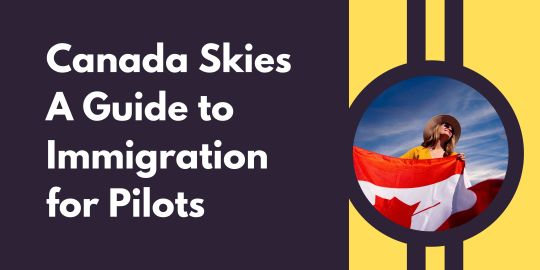
Canada's vast landscape, from its snow-capped mountains to its bustling cities, offers a unique allure for pilots seeking new horizons. If you're a pilot dreaming of soaring through Canadian skies, understanding the Canada Immigration process is your first step towards making that dream a reality.
Why Canada?
Canada is renowned for its high standard of living, cultural diversity, and stunning natural beauty. For pilots, it offers a range of opportunities, from commercial aviation to scenic flights over breathtaking landscapes. Whether you're drawn to the northern wilderness of Yukon or the cosmopolitan charm of Toronto, Canada has something for every aviator.
Understanding Immigration
Before you can start flying in Canada, you'll need to navigate the immigration process. Canada welcomes skilled workers from around the world through various immigration programs. As a pilot, you may be eligible for programs such as the Express Entry system, Provincial Nominee Programs (PNPs), or the Atlantic Immigration Pilot.
Express Entry System
The Express Entry system is a fast-track immigration program for skilled workers. It manages applications for three federal economic immigration programs: the Federal Skilled Worker Program, the Federal Skilled Trades Program, and the Canadian Experience Class. To qualify, you'll need to meet certain criteria, including language proficiency, education, work experience, and adaptability factors.
Provincial Nominee Programs (PNPs)
Provincial Nominee Programs allow Canadian provinces and territories to nominate individuals with the skills and experience needed in their local labor markets. Each province has its own set of criteria and streams, some of which may be specifically tailored for pilots or aviation professionals. Researching PNPs and their eligibility requirements is essential for aspiring pilots looking to immigrate to Canada.
Atlantic Immigration Pilot
The Atlantic Immigration Pilot is a unique program designed to address labor market needs in Canada's Atlantic provinces: Nova Scotia, New Brunswick, Newfoundland and Labrador, and Prince Edward Island. Employers in these provinces can hire foreign workers, including pilots, through this program if they are unable to find suitable candidates locally. If you secure a job offer from an eligible employer in the Atlantic region, you may be able to immigrate to Canada through this pilot program.
Preparing Your Application
Once you've determined which immigration program suits your qualifications and aspirations, it's time to prepare your application. This typically involves gathering necessary documents, such as your passport, educational credentials, proof of work experience, language test results, and any other supporting documents required by the chosen immigration program.
Seeking Professional Assistance
Navigating the immigration process can be complex, especially for those unfamiliar with Canadian immigration laws and procedures. Consider seeking assistance from immigration consultants or lawyers specializing in Canadian immigration. They can provide valuable guidance and support throughout the application process, increasing your chances of success.
Conclusion
Canada's skies beckon pilots from around the world with promises of adventure, opportunity, and breathtaking vistas. By understanding the Canada Immigration process and exploring the various pathways available, you can turn your dream of flying in Canada into a reality. With determination, preparation, and perhaps a little professional assistance, you'll soon find yourself soaring through the Great White North, experiencing firsthand the beauty and diversity that Canada has to offer.
0 notes
Text
4 Ways to canada immigration After 40 years of Age

Are you dreaming of starting a new chapter of your life in Canada but worried about your age? Don't fret! While immigrating after 40 may seem daunting, there are several pathways you can explore to make your Canadian dream a reality. Here are four simplified ways to Canada Immigration after the age of 40:
Express Entry: The Skilled Worker Route
Express Entry is a fast-track immigration system for skilled workers. Even if you're over 40, you can still qualify if you have valuable skills and work experience. To apply, you'll need to create an online profile and undergo an evaluation based on factors like your age, education, work experience, and language proficiency in English or French. If you score high enough, you may receive an Invitation to Apply (ITA) for permanent residency.
Provincial Nominee Programs (PNPs)
Many Canadian provinces have their own immigration programs designed to address their specific labor market needs. These Provincial Nominee Programs (PNPs) often offer pathways for skilled workers, entrepreneurs, and investors. Some PNPs have streams that prioritize candidates with work experience in-demand occupations, regardless of age. Research the PNPs of provinces where your skills are in demand and explore your options.
Study and Work Permits: The Student Route
Age is not a barrier to education! Consider pursuing further studies in Canada as a pathway to permanent residency. By enrolling in a Canadian educational institution and obtaining a study permit, you can gain valuable Canadian education and work experience. After completing your studies, you may be eligible for a Post-Graduation Work Permit, which can lead to permanent residency through programs like the Canadian Experience Class or Provincial Nominee Programs.
Family Sponsorship: The Family Route
If you have close family members who are Canadian citizens or permanent residents, they may be able to sponsor you for immigration. This route is available to spouses, common-law partners, parents, grandparents, and dependent children. If you have a family member willing to sponsor you, explore the eligibility requirements and application process for family sponsorship.
Remember, Canada Immigration is a complex process, and each pathway has its own requirements and challenges. It's essential to do thorough research, consult with immigration experts if possible, and carefully prepare your application to maximize your chances of success. While age may be a factor, it's not insurmountable. With determination, perseverance, and the right approach, your Canadian dream can become a reality, no matter your age!
0 notes
Text
How to canada immigration as a Taxi driver
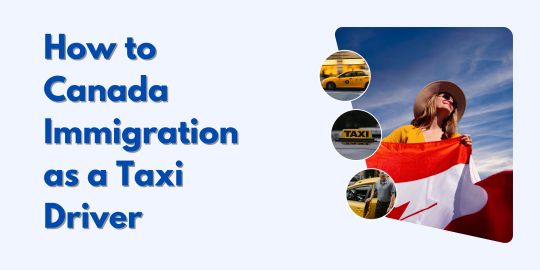
Are you dreaming of moving to Canada to start a new life as a taxi driver? Canada is a land of opportunities, and if you have the skills and determination, you can make your dream a reality. In this guide, we'll walk you through the steps you need to take to Canada Immigration as a taxi driver.
Step 1: Check Your Eligibility
Before you start the immigration process, you need to make sure you meet the eligibility requirements. To work as a taxi driver in Canada, you'll typically need a valid driver's license and a clean driving record. You may also need to meet certain health and character requirements.
Step 2: Research Immigration Programs
Canada offers several immigration programs for skilled workers, including those in transportation and logistics. One popular option is the Express Entry system, which manages applications for three federal economic immigration programs: the Federal Skilled Worker Program, the Federal Skilled Trades Program, and the Canadian Experience Class.
If you have experience as a taxi driver and meet the eligibility criteria for one of these programs, you may be able to immigrate to Canada through Express Entry.
Step 3: Gather Required Documents
Once you've determined which immigration program you're eligible for, you'll need to gather the required documents for your application. This may include proof of identity, education credentials, language test results, and proof of work experience as a taxi driver.
Step 4: Take Language Tests
Proficiency in English or French is essential for working as a taxi driver in Canada. Depending on the immigration program you're applying to, you may need to take a language test, such as the IELTS for English or the TEF for French, to demonstrate your language abilities.
Step 5: Submit Your Application
Once you have all the necessary documents and language test results, you can submit your immigration application. If you're applying through the Express Entry system, you'll need to create an online profile and submit your profile to the pool of candidates. If you're applying through a different immigration program, you'll need to follow the specific instructions for that program.
Step 6: Wait for a Decision
After you've submitted your application, you'll need to wait for a decision from Canadian immigration authorities. The processing time can vary depending on the program you're applying through and other factors, so it's important to be patient.
Step 7: Prepare for Arrival
If your application is approved, congratulations! You'll need to prepare for your move to Canada. This may include securing housing, arranging transportation, and familiarizing yourself with Canadian laws and regulations related to taxi driving.
Step 8: Start Your New Life in Canada
Once you've arrived in Canada, it's time to start your new life as a taxi driver. Whether you're driving through the bustling streets of Toronto, the charming neighborhoods of Montreal, or the scenic roads of Vancouver, Canada offers endless opportunities for taxi drivers to thrive.
In conclusion, Canada Immigration as a taxi driver is a rewarding journey that requires careful planning and preparation. By following these steps and staying determined, you can make your dream of living and working in Canada a reality.
0 notes
Text
Canada Immigration Process, Requirements & Cost
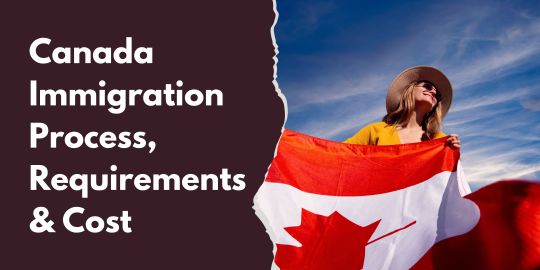
Canada is known for its welcoming attitude towards immigrants, offering numerous opportunities for those seeking to build a new life in a diverse and vibrant country. If you're considering immigrating to Canada, you might be wondering about the process, requirements, and costs involved. This guide aims to provide you with a straightforward overview to help you navigate through the Canada Immigration journey.
Understanding the Process
1. Determine Your Eligibility:
Before you begin the immigration process, it's essential to determine which immigration program suits you best. Canada offers various pathways for immigration, including Express Entry, Provincial Nominee Programs (PNPs), Family Sponsorship, and more.
2. Choose the Right Immigration Program:
Once you've assessed your eligibility, choose the immigration program that aligns with your qualifications, work experience, and future plans. Each program has its own set of requirements and criteria, so research thoroughly to make an informed decision.
3. Gather Required Documents:
Prepare all necessary documents such as identification, educational credentials, proof of work experience, language proficiency test results (such as IELTS or CELPIP), and any other supporting documentation as per the requirements of your chosen immigration program.
4. Submit Your Application:
Complete and submit your application through the designated immigration portal or office. Ensure accuracy and completeness to avoid delays or rejection. Some programs may require additional steps such as medical examinations or police certificates.
5. Wait for Processing:
After submitting your application, it will undergo processing by Canadian immigration authorities. Processing times vary depending on the program, the volume of applications, and other factors. You can check the status of your application online through the official portal.
6. Receive a Decision:
Once your application is processed, you will receive a decision from Canadian immigration authorities. If approved, you'll receive instructions on next steps, such as obtaining a visa or permanent resident status. If rejected, you may have the option to appeal or reapply, depending on the circumstances.
Requirements for Immigration
1. Language Proficiency:
Most immigration programs require applicants to demonstrate proficiency in English or French through standardized language tests. Minimum scores are specified for each program, so be sure to meet or exceed these requirements.
2. Education and Work Experience:
Educational credentials and work experience play a significant role in the immigration process. You may need to have your credentials assessed to ensure they meet Canadian standards. Work experience should be relevant to your chosen immigration program and verified through documentation.
3. Proof of Funds:
Many immigration programs require applicants to show that they have sufficient funds to support themselves and their families upon arrival in Canada. The amount varies depending on family size and other factors.
4. Medical and Security Clearances:
Applicants are typically required to undergo medical examinations to ensure they meet health requirements for immigration. Additionally, background checks and police certificates may be necessary to demonstrate good character and security clearance.
Cost of Immigration
Application Fees:
Each immigration program has its own set of application fees, which may vary depending on factors such as the type of application, the number of family members included, and processing times. Be sure to check the latest fee schedule before submitting your application.
Additional Expenses:
In addition to application fees, applicants may incur other expenses such as language tests, educational credential assessments, medical examinations, police certificates, and immigration consultancy fees if you choose to seek professional assistance.
Settlement Funds:
While not a direct cost of the immigration process, applicants need to have sufficient settlement funds to support themselves and their families upon arrival in Canada. These funds should cover expenses such as housing, food, and transportation until you secure employment.
Conclusion
Navigating the Canada Immigration process can seem daunting, but with proper understanding of the requirements, process, and costs involved, you can approach it with confidence. Remember to research thoroughly, gather all necessary documentation, and be prepared for possible delays or challenges along the way. With determination and perseverance, Canada could soon become your new home, offering opportunities for a bright and promising future.
0 notes
Text
Immigration to Canada as a Truck Driver: A Simple Guide
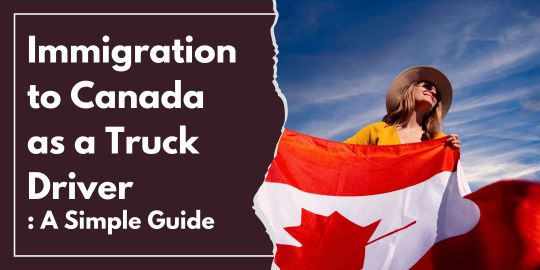
Canada, with its vast landscapes and thriving economy, is an appealing destination for many looking to build a better future. For truck drivers seeking new opportunities, Canada offers a pathway to a stable career and a high quality of life. In this guide, we'll walk you through the basics of Canada Immigration as a truck driver, keeping things simple and easy to understand.
Understanding the Basics
Before diving into the immigration process, it's essential to understand the basic requirements and options available to truck drivers looking to move to Canada.
1. Eligibility Criteria: To qualify as a truck driver for immigration purposes, you typically need to meet certain criteria, including having a valid commercial driver's license (CDL) or its equivalent from your home country. You should also have experience in driving heavy trucks or tractor-trailers.
2. Job Demand: Canada has a high demand for truck drivers, especially in industries such as logistics, transportation, and construction. Having experience in these sectors can enhance your chances of finding employment in Canada.
3. Immigration Programs: There are several immigration programs through which truck drivers can immigrate to Canada. The most common ones include the Express Entry system, Provincial Nominee Programs (PNPs), and the Temporary Foreign Worker Program (TFWP).
Express Entry System: This system is a point-based immigration system that assesses candidates based on factors like age, education, work experience, and language proficiency. Truck drivers may qualify under the Federal Skilled Worker Program (FSWP) or the Canadian Experience Class (CEC) if they have previous work experience in Canada.
Provincial Nominee Programs (PNPs): Many provinces in Canada have their own immigration programs designed to meet their specific labor market needs. Some provinces offer pathways for truck drivers to immigrate directly through their PNPs, provided they meet certain criteria and have a job offer from an employer in that province.
Temporary Foreign Worker Program (TFWP): If you have a job offer from a Canadian employer, you may be eligible to come to Canada temporarily under the TFWP. This program allows employers to hire foreign workers to fill temporary labor shortages in Canada.
Language Requirements: Proficiency in English or French is crucial for truck drivers working in Canada. Most immigration programs require candidates to take a language test, such as the International English Language Testing System (IELTS) or the Canadian English Language Proficiency Index Program (CELPIP).
Financial Considerations: Moving to a new country involves financial planning. You'll need to consider expenses such as visa application fees, travel costs, accommodation, and initial living expenses until you start earning in Canada.
Seeking Employment
Before applying for immigration, it's advisable to secure a job offer from a Canadian employer. Many trucking companies in Canada actively recruit foreign workers to fill their staffing needs. You can search for job openings online, reach out to recruitment agencies, or attend job fairs and trade shows to network with potential employers.
When applying for jobs, make sure your resume highlights your relevant experience, skills, and qualifications as a truck driver. Be prepared for interviews, which may be conducted via phone or video call if you're still residing in your home country.
The Immigration Process
Once you have a job offer and meet the eligibility criteria for an immigration program, you can begin the application process. Depending on the program you're applying through, the process may vary slightly, but generally, it involves the following steps:
Create an Online Profile: For programs like Express Entry, you'll need to create an online profile and provide information about your skills, work experience, education, language proficiency, and other relevant details.
Submit Documents: You'll be required to submit supporting documents, such as educational credentials, work experience letters, language test results, and proof of funds (if applicable).
Receive an Invitation to Apply (ITA): If you meet the eligibility criteria and have enough points (for Express Entry), you may receive an ITA to apply for permanent residency.
Complete Medical and Security Checks: As part of the application process, you'll need to undergo medical examinations and provide police clearance certificates to prove that you don't pose a security risk.
Receive Permanent Residency: Once your application is approved, you'll receive your permanent resident visa, allowing you to live and work in Canada indefinitely.
Settling in Canada
Moving to a new country can be both exciting and challenging. Once you arrive in Canada, there are several things you'll need to take care of to settle in smoothly:
Find Accommodation: Whether you choose to rent or buy, finding suitable accommodation is a top priority. You can search for rental listings online or work with a real estate agent to find a place that meets your needs.
Get Health Insurance: Canada has a publicly funded healthcare system, but it's essential to apply for provincial health insurance as soon as you arrive to ensure you're covered for medical services.
Apply for Social Insurance Number (SIN): You'll need a SIN to work and access government benefits and services in Canada. You can apply for a SIN at a Service Canada office by providing the required documents.
Explore Your New Home: Take the time to explore your new surroundings, get to know your neighborhood, and familiarize yourself with local amenities, such as schools, hospitals, and public transportation.
Final Thoughts
Immigrating to Canada as a truck driver offers numerous opportunities for a better future and a high standard of living. By understanding the Canada Immigration process, securing a job offer, and planning your move effectively, you can embark on a new journey towards success and prosperity in the Great White North.
0 notes
Text
Canadian Immigration via Express Entry — A step by step guide
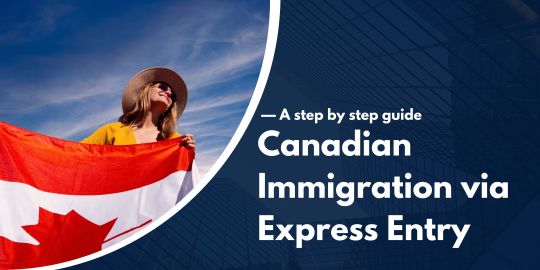
Are you dreaming of making Canada your new home? The good news is that Canada welcomes immigrants through various programs, and one of the most popular pathways is the Express Entry system. This streamlined process allows skilled workers to apply for permanent residency in Canada. If you're ready to embark on this journey, here's a simple step-by-step guide to help you navigate the Canada Immigration process via Express Entry.
Step 1: Determine Your Eligibility Before you start the application process, it's essential to ensure you meet the basic requirements for Express Entry. You must qualify under one of the three federal economic immigration programs: the Federal Skilled Worker Program, the Federal Skilled Trades Program, or the Canadian Experience Class. Each program has its own set of eligibility criteria based on factors like education, work experience, language proficiency, and adaptability.
Step 2: Take an Approved Language Test Language proficiency is a crucial aspect of the Express Entry system. To prove your language skills, you'll need to take an approved language test in either English or French. The two accepted language tests are the International English Language Testing System (IELTS) for English and the Test d'évaluation de français (TEF) for French. Your test results will determine your language score, which plays a significant role in your Express Entry profile.
Step 3: Obtain an Educational Credential Assessment (ECA) If you completed your education outside of Canada, you'll need to get an Educational Credential Assessment (ECA). This assessment verifies that your foreign degree, diploma, or certificate is equivalent to a Canadian one. It's an essential step for proving your qualifications to the Canadian authorities and ensuring your eligibility for Express Entry.
Step 4: Create an Express Entry Profile Once you've gathered all the necessary documents and determined your eligibility, it's time to create an Express Entry profile online. You'll need to provide detailed information about your education, work experience, language skills, and other personal details. Based on this information, you'll be assigned a Comprehensive Ranking System (CRS) score, which ranks you against other Express Entry candidates.
Step 5: Receive an Invitation to Apply (ITA) Candidates with high CRS scores are entered into the Express Entry pool, where they compete for invitations to apply for permanent residency. Periodically, the Canadian government conducts draws from the pool and issues Invitations to Apply (ITAs) to candidates with the highest scores. If you receive an ITA, congratulations! You can now proceed to the final stage of the application process.
Step 6: Submit Your Application for Permanent Residency Upon receiving an ITA, you'll have a limited time (usually 60 days) to submit your complete application for permanent residency. This includes providing supporting documents, such as police certificates, medical exams, and proof of funds to support yourself and your family in Canada. Once your application is submitted, it will be reviewed by immigration officials, and if everything checks out, you'll be granted permanent residency status.
Step 7: Prepare for Your Move to Canada Once your permanent residency is approved, it's time to prepare for your move to Canada. You'll need to plan your travel arrangements, secure housing, and familiarize yourself with Canadian culture and society. Upon arrival, you'll need to complete landing procedures to officially become a permanent resident of Canada.
In conclusion, Canada Immigration through the Express Entry system offers a straightforward pathway to permanent residency for skilled workers. By following this step-by-step guide and ensuring you meet all the requirements, you can increase your chances of success in making Canada your new home.
0 notes
Text
Top Advantages and Disadvantages Of Moving To Canada
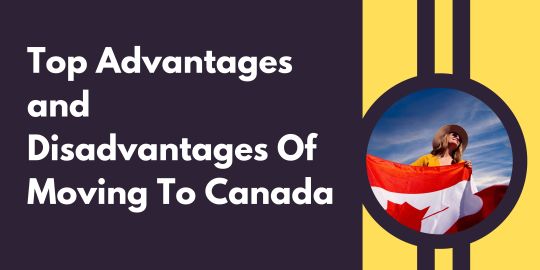
Moving to a new country is a big decision that can bring both excitement and challenges. Canada, known for its natural beauty, friendly people, and diverse culture, is a popular destination for Canada Immigration from around the world. Before packing your bags and heading north, it's essential to consider the advantages and disadvantages of making Canada your new home.
Advantages:
Quality of Life: Canada consistently ranks high in global quality of life indexes due to its excellent healthcare, education system, and overall safety. Residents enjoy access to universal healthcare, clean air, and a high standard of living.
Diversity and Inclusivity: Canada is celebrated for its multiculturalism and welcoming attitude towards immigrants. People from all backgrounds are embraced, fostering a sense of belonging and acceptance.
Economic Opportunities: With a stable economy and low unemployment rates, Canada offers ample job opportunities across various industries. Additionally, the country values skilled workers and provides pathways to permanent residency for those with desirable skills.
Natural Beauty: From breathtaking landscapes like the Rocky Mountains to picturesque coastlines, Canada boasts stunning natural beauty. Outdoor enthusiasts can indulge in activities like hiking, skiing, and wildlife viewing.
Education System: Canada's education system is renowned for its quality and affordability. Access to top-notch universities and colleges, along with support for international students, makes it an attractive destination for education seekers.
Disadvantages:
Harsh Weather: Canada's winters can be harsh, especially in regions like Alberta and Saskatchewan, where temperatures can plummet well below freezing. Adjusting to cold weather and snowfall may be challenging for newcomers.
Cost of Living: While Canada offers a high standard of living, the cost of living in major cities like Toronto and Vancouver can be steep. Housing prices, in particular, have been rising steadily, making it difficult for some to afford decent accommodation.
Lengthy Immigration Process: The process of immigrating to Canada can be lengthy and complex, requiring patience and careful documentation. Applicants may face delays and bureaucratic hurdles during the immigration process.
Cultural Adjustment: While Canada is known for its diversity, adjusting to a new culture and way of life can still be daunting. Language barriers, social norms, and cultural differences may pose challenges for newcomers.
Healthcare Wait Times: While Canada's healthcare system is praised for its universality, some residents may experience long wait times for non-emergency medical services. This issue can be frustrating for those accustomed to quicker access to healthcare services.
In conclusion, moving to Canada offers numerous advantages, including a high quality of life, economic opportunities, and a diverse, inclusive society. However, it's essential to consider the potential challenges, such as harsh weather, high living costs, and the intricacies of the Canada Immigration process. Ultimately, with proper planning and realistic expectations, relocating to Canada can be a rewarding experience for individuals and families seeking a better life.
0 notes
Text
5 Simple Ways Nurses Can Immigrate to Canada
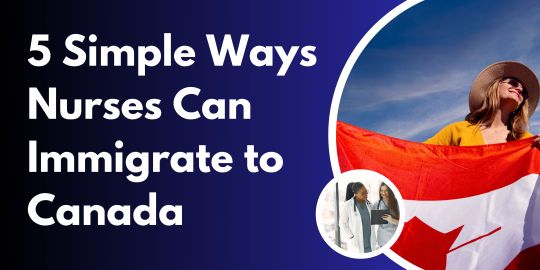
Are you a nurse dreaming of starting a new chapter in Canada? You're not alone! Canada offers fantastic opportunities for nurses looking to immigrate. Whether you're seeking adventure, better job prospects, or a fresh start, Canada might be the perfect destination for you. Here are five straightforward ways for nurses to make their Canada Immigration dreams a reality:
Express Entry Program: The Express Entry Program is like a fast pass for skilled workers, including nurses, to immigrate to Canada. Through this program, you'll need to create an online profile showcasing your skills, work experience, education, and language proficiency. Your profile will then be ranked using a points system, and if you score high enough, you'll receive an Invitation to Apply (ITA) for permanent residency. Make sure to check if your occupation is in demand in Canada before applying.
Provincial Nominee Program (PNP): Each province and territory in Canada has its own PNP, some of which have specific streams for healthcare professionals like nurses. These programs allow provinces to nominate individuals who have the skills and experience needed in their local labor market. Research which province aligns best with your qualifications and apply directly to their PNP stream for healthcare workers.
Study and Work Permit: Another route to consider is studying in Canada. Many universities and colleges offer nursing programs that can lead to work opportunities upon graduation. After completing your studies, you can apply for a Post-Graduation Work Permit, allowing you to gain valuable Canadian work experience. This experience can then open doors to permanent residency through programs like Express Entry or provincial nominee streams.
Atlantic Immigration Pilot: If you're interested in living and working in Canada's Atlantic provinces (Nova Scotia, New Brunswick, Prince Edward Island, and Newfoundland and Labrador), the Atlantic Immigration Pilot (AIP) might be the path for you. This employer-driven program aims to fill labor gaps in the Atlantic region by helping employers hire skilled workers like nurses. If you have a job offer from a designated employer in one of these provinces, you could be on your way to permanent residency.
Caregiver Program: Canada values caregivers, including nurses, who provide essential services to families and individuals in need. The Home Child Care Provider and Home Support Worker pilots offer pathways to permanent residency for caregivers who meet specific criteria. If you have experience as a nurse caring for individuals in their homes, you may be eligible to apply under one of these programs.
Before embarking on your immigration journey to Canada, it's essential to thoroughly research each option and determine which pathway aligns best with your qualifications, goals, and preferences. Additionally, consider seeking guidance from immigration consultants or lawyers specializing in Canada Immigration to ensure a smooth and successful transition. With dedication and careful planning, you could soon find yourself living your Canadian dream as a nurse in the Great White North!
0 notes
Text
Apply for Canada Immigration as a Nurse in 2024
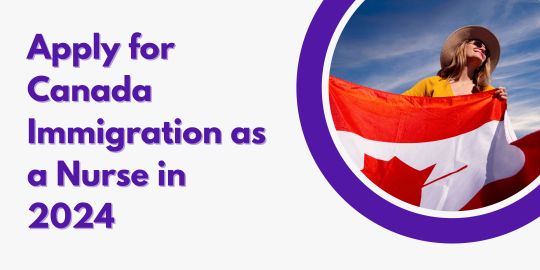
Are you a nurse dreaming of starting a new chapter in Canada? Well, you're in luck! Canada is actively seeking skilled nurses to join its healthcare workforce, making it a great destination for those looking to immigrate. In this guide, we'll walk you through the steps to apply for Canada Immigration as a nurse in 2024.
1. Understand the Requirements
Before diving into the application process, it's important to understand the requirements for immigrating to Canada as a nurse. Generally, you'll need to meet certain criteria such as having a valid nursing license, relevant work experience, and English or French language proficiency.
2. Check Your Eligibility
To ensure you meet the criteria set by the Canadian government, take some time to assess your eligibility. You can use online tools like the Come to Canada wizard on the Government of Canada website to determine your eligibility and explore the various immigration programs available.
3. Choose the Right Immigration Program
Canada offers several immigration pathways for skilled workers, including nurses. Some popular programs to consider include the Express Entry system, Provincial Nominee Programs (PNPs), and the Atlantic Immigration Pilot. Each program has its own set of requirements and application process, so research thoroughly to find the one that best suits your situation.
4. Gather Required Documents
Once you've identified the immigration program you want to apply for, it's time to gather all the necessary documents. This typically includes your passport, educational credentials, proof of work experience, language test results, and any other supporting documents specified by the program.
5. Submit Your Application
With your documents in hand, you can now submit your application through the online portal or by mail, depending on the program requirements. Be sure to double-check all the information provided and pay any required fees to avoid delays in processing.
6. Wait for Processing
After submitting your application, it will be processed by the relevant immigration authorities. Processing times can vary depending on the program and your individual circumstances, so be patient and stay informed by checking the status of your application regularly.
7. Prepare for Arrival
Once your application is approved, it's time to prepare for your move to Canada! This may involve obtaining a work permit, arranging housing, and familiarizing yourself with Canadian culture and healthcare practices.
8. Start Your New Life in Canada
Congratulations! You've successfully immigrated to Canada as a nurse. Now it's time to embark on this exciting new chapter of your life, where you'll have the opportunity to contribute to Canada's healthcare system while enjoying the many benefits of living in this diverse and welcoming country.
In conclusion, Canada Immigration as a nurse in 2024 is a realistic and achievable goal for those willing to put in the effort. By understanding the requirements, choosing the right immigration program, and following the application process diligently, you can make your dream of living and working in Canada a reality.
0 notes
Text
Provincial Nominee Programs: Your Pathway to Canadian Immigration

Are you dreaming of starting a new life in Canada? If so, you might have heard about Provincial Nominee Programs (PNPs). These programs offer a fantastic opportunity for individuals and families to immigrate to Canada and settle in specific provinces or territories. Let's delve into what PNPs are all about and how they can be your ticket to Canadian residency.
What are Provincial Nominee Programs?
Provincial Nominee Programs are Canada Immigration programs run by Canadian provinces and territories. Each province or territory has its own PNP tailored to its unique needs and priorities. These programs allow provinces to select immigrants who have the skills, experience, and qualities required to contribute to their local economy and community.
How do Provincial Nominee Programs Work?
Here's a simplified breakdown of how PNPs typically operate:
Eligibility Criteria: Each PNP has its own set of eligibility criteria based on factors such as education, work experience, language proficiency, and ties to the province. These criteria vary from one province to another.
Application Process: To apply for a provincial nomination, you'll need to follow the specific guidelines outlined by the province or territory you're interested in. This usually involves submitting an expression of interest or application through an online portal.
Nomination: If your application meets the requirements and aligns with the priorities of the province, you may receive a nomination from that province. A provincial nomination significantly boosts your chances of being invited to apply for permanent residency by the federal government.
Federal Immigration Application: Once you receive a provincial nomination, you can use it to apply for permanent residency through Immigration, Refugees, and Citizenship Canada (IRCC). The federal government will assess your application based on its own eligibility criteria, including security and medical checks.
Settlement and Integration: After obtaining permanent residency, you and your family can settle in the province that nominated you. Many provinces offer support services to help newcomers integrate into Canadian society, find employment, and access essential amenities.
Why Choose a Provincial Nominee Program?
Here are some reasons why PNPs are a popular choice for immigrants:
Tailored Selection: PNPs allow provinces to select immigrants who possess the skills and attributes needed to address local labor market gaps and contribute to economic growth.
Faster Processing: Provincial nominees often receive priority processing of their permanent residency applications, resulting in quicker immigration timelines compared to other immigration streams.
Regional Opportunities: Each province has its own unique economic opportunities and quality of life factors. PNPs enable immigrants to choose a province that best aligns with their preferences and aspirations.
Community Support: Many provinces offer settlement services and community support networks to help immigrants successfully integrate into their new environment.
Conclusion
Provincial Nominee Programs offer a straightforward pathway to Canada Immigration for individuals and families seeking new opportunities in different parts of the country. By meeting the eligibility criteria and receiving a provincial nomination, you can embark on an exciting journey towards permanent residency in Canada. Whether you're drawn to the bustling cities of Ontario, the stunning landscapes of British Columbia, or the vibrant communities of Atlantic Canada, PNPs open doors to a brighter future in the Great White North.
0 notes
Text
Canada Immigration: A Guide for Healthcare Workers
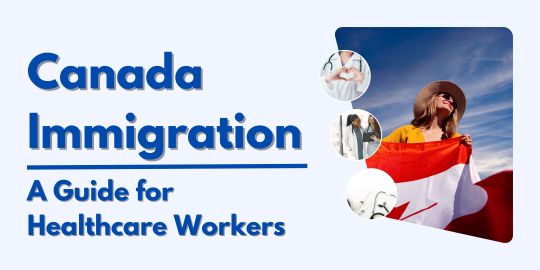
Canada is renowned for its high-quality healthcare system, and as the demand for healthcare professionals continues to rise, the country welcomes skilled workers from around the world to contribute to its healthcare sector. If you're a healthcare worker considering Canada Immigration here's what you need to know.
Understanding the Requirements
To immigrate to Canada as a healthcare worker, you'll need to meet certain requirements set by the Canadian government. These requirements may vary depending on the province or territory you plan to work in, as well as your specific profession within the healthcare sector.
Eligibility Criteria
Generally, to be eligible for immigration as a healthcare worker, you must have a recognized professional qualification in your field. This could include being a doctor, nurse, pharmacist, physiotherapist, or other healthcare professionals. Additionally, you may need to demonstrate your proficiency in English or French, as these are the official languages of Canada.
Express Entry System
One of the pathways for skilled workers, including healthcare professionals, to immigrate to Canada is through the Express Entry system. This system manages applications for three federal economic immigration programs: the Federal Skilled Worker Program, the Federal Skilled Trades Program, and the Canadian Experience Class. Healthcare workers with the necessary qualifications and work experience may be eligible to apply through one of these programs.
Provincial Nominee Programs (PNPs)
Many provinces and territories in Canada have their own immigration programs designed to meet their specific labor market needs. These programs often target healthcare professionals, offering opportunities for skilled workers to immigrate to Canada through nomination by a specific province or territory. Each PNP has its own eligibility criteria and application process, so it's essential to research the requirements of the province or territory you're interested in.
Job Opportunities
Canada's aging population and increasing healthcare needs have led to a growing demand for healthcare professionals across the country. Whether you're interested in working in hospitals, clinics, long-term care facilities, or other healthcare settings, there are ample job opportunities available for skilled healthcare workers in Canada.
Benefits of Immigrating to Canada
Immigrating to Canada as a healthcare worker offers numerous benefits, including access to high-quality healthcare services for you and your family, excellent educational opportunities, a safe and welcoming environment, and a high standard of living.
Conclusion
If you're a healthcare professional looking to immigrate to Canada, there are various pathways available to you. Whether you choose to apply through the Express Entry system or a Provincial Nominee Program, Canada Immigration welcomes skilled workers like you to contribute to its vibrant healthcare sector. With its excellent job opportunities, quality of life, and welcoming atmosphere, Canada may be the perfect destination for your professional and personal growth.
0 notes
Text
Top 10 Canada Immigration Options for Skilled Workers
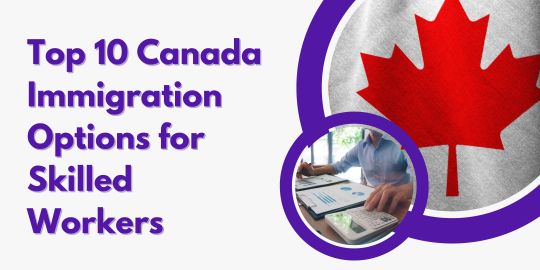
Canada is known for its welcoming attitude towards skilled workers from all around the world. If you're considering Canada Immigration for work, you've made a great choice! But with so many options available, it can be challenging to figure out which one is right for you. Here's a simple breakdown of the top 10 Canada immigration options for skilled workers:
Express Entry:
Express Entry is the fastest and most popular way for skilled workers to immigrate to Canada.
It manages applications for three federal economic immigration programs: the Federal Skilled Worker Program, the Federal Skilled Trades Program, and the Canadian Experience Class.
Provincial Nominee Program (PNP):
Each Canadian province and territory has its own PNP, designed to meet its specific economic needs.
PNPs allow provinces to nominate individuals who wish to immigrate to Canada and settle in a particular province.
Atlantic Immigration Pilot Program (AIPP):
The AIPP is a partnership between the Government of Canada and the Atlantic provinces (Nova Scotia, New Brunswick, Newfoundland and Labrador, and Prince Edward Island).
It aims to attract skilled workers to the Atlantic region to fill job vacancies and support economic growth.
Quebec Skilled Worker Program (QSWP):
Quebec has its own immigration programs separate from those of the federal government.
The QSWP is for skilled workers who wish to settle in Quebec.
Rural and Northern Immigration Pilot:
This pilot program is designed to help smaller communities in Canada attract skilled workers.
It allows communities to recommend eligible candidates for permanent residence.
Start-Up Visa Program:
The Start-Up Visa Program is for entrepreneurs who want to start a business in Canada.
It links immigrant entrepreneurs with experienced private sector organizations that have expertise in working with start-ups.
Agri-Food Immigration Pilot:
This pilot program is for workers in specific agri-food industries.
It aims to address labor shortages by providing a pathway to permanent residence for eligible foreign workers.
Caregivers Program:
Canada offers programs for caregivers who provide care for children, elderly persons, or individuals with high medical needs.
Caregivers may be eligible for permanent residence after fulfilling certain requirements.
Global Talent Stream:
The Global Talent Stream facilitates the hiring of highly skilled foreign workers for Canadian companies.
It offers a fast-track work permit process for certain skilled occupations.
Family Sponsorship:
Canadian citizens and permanent residents can sponsor their family members to come to Canada.
This includes spouses, partners, dependent children, parents, and grandparents.
Before choosing an Canada Immigration program, it's essential to consider your qualifications, work experience, language skills, and personal preferences. Each program has its own eligibility criteria and application process, so it's a good idea to research thoroughly and seek professional advice if needed. Canada offers diverse opportunities for skilled workers looking to make a new home, so explore your options and take the first step towards your Canadian dream!
0 notes
Text
13 Ways to Immigrate to Canada in 2024: Your Simple Guide
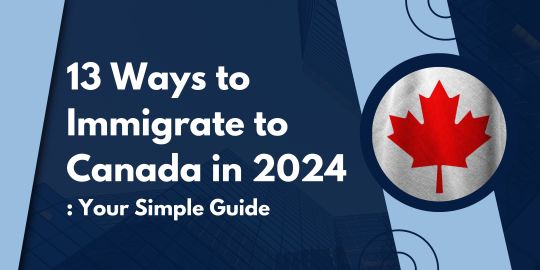
Canada, with its stunning landscapes, diverse culture, and robust economy, continues to be a sought-after destination for immigrants worldwide. If you're considering making Canada your new home in 2024, you're in luck! There are various pathways available to make your Canada Immigration dreams a reality. Here are 13 simple ways you can go about immigrating to Canada this year:
Express Entry System: This is one of the most popular immigration routes for skilled workers. Through Express Entry, you can apply for permanent residency as a skilled worker based on your education, work experience, language abilities, and other factors.
Provincial Nominee Program (PNP): Each Canadian province and territory has its own PNP, which allows them to nominate individuals who meet specific criteria for immigration to that province.
Study Permit: If you wish to pursue higher education in Canada, obtaining a study permit could be your ticket. After completing your studies, you may be eligible for a post-graduation work permit, which can eventually lead to permanent residency.
Family Sponsorship: If you have a family member who is a Canadian citizen or permanent resident, they may be able to sponsor you for immigration to Canada.
Start-Up Visa Program: Entrepreneurs with innovative business ideas may qualify for the Start-Up Visa Program, which allows them to immigrate to Canada and start their businesses.
Caregiver Program: If you have experience working as a caregiver, you may be eligible to apply for permanent residency through the Caregiver Program.
Atlantic Immigration Pilot: This program is designed to attract skilled workers to the Atlantic provinces of Canada: New Brunswick, Newfoundland and Labrador, Nova Scotia, and Prince Edward Island.
Rural and Northern Immigration Pilot: Similar to the Atlantic Immigration Pilot, this program aims to address labor shortages in rural and northern communities by welcoming skilled workers and their families.
Quebec Immigration: Quebec has its own Canada Immigration programs and selection criteria. If you wish to settle in Quebec, you'll need to apply through the Quebec Skilled Worker Program or other provincial streams.
Refugee and Asylum Programs: Canada is known for its compassionate approach to refugees. If you're fleeing persecution or violence in your home country, you may be eligible to seek refuge in Canada.
Self-Employed Persons Program: Artists, athletes, and individuals engaged in cultural or agricultural activities may qualify for permanent residency through the Self-Employed Persons Program.
Agri-Food Immigration Pilot: This pilot program is aimed at addressing labor shortages in the agri-food sector by allowing eligible workers to immigrate to Canada.
Global Talent Stream: Highly skilled workers in certain fields, such as technology, may be eligible for fast-track processing through the Global Talent Stream.
No matter which pathway you choose, immigrating to Canada requires careful planning and attention to detail. It's essential to thoroughly research your options and ensure that you meet the eligibility criteria for your chosen program. With determination and perseverance, you can make your Canadian dream a reality in 2024!
0 notes